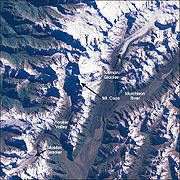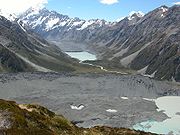
Mueller Glacier
Encyclopedia


Glacier
A glacier is a large persistent body of ice that forms where the accumulation of snow exceeds its ablation over many years, often centuries. At least 0.1 km² in area and 50 m thick, but often much larger, a glacier slowly deforms and flows due to stresses induced by its weight...
flowing through Aoraki/Mount Cook National Park
Aoraki/Mount Cook National Park
Aoraki/Mount Cook National Park is in the South Island of New Zealand near the town of Twizel. Aoraki/Mount Cook, New Zealand's highest mountain and Aoraki/Mount Cook village lie within the park...
in the South Island
South Island
The South Island is the larger of the two major islands of New Zealand, the other being the more populous North Island. It is bordered to the north by Cook Strait, to the west by the Tasman Sea, to the south and east by the Pacific Ocean...
of New Zealand
New Zealand
New Zealand is an island country in the south-western Pacific Ocean comprising two main landmasses and numerous smaller islands. The country is situated some east of Australia across the Tasman Sea, and roughly south of the Pacific island nations of New Caledonia, Fiji, and Tonga...
. It lies to the south of Aoraki/Mount Cook
Aoraki/Mount Cook
Aoraki / Mount Cook is the highest mountain in New Zealand, reaching .It lies in the Southern Alps, the mountain range which runs the length of the South Island. A popular tourist destination, it is also a favourite challenge for mountain climbers...
, high in the Southern Alps
Southern Alps
The Southern Alps is a mountain range extending along much of the length of New Zealand's South Island, reaching its greatest elevations near the island's western side...
, and flows north. Its meltwaters eventually join the Tasman River
Tasman River
The Tasman River is an alpine braided river flowing through Canterbury, in New Zealand's South Island.The river's headwaters are in Aoraki/Mount Cook National Park, where it is the outflow of the Tasman and Murchison Glaciers and also, via a short tributary, of the Hooker and Mueller Glaciers.It...
.
The glacier was named after German-Australian
German Australian
German religious refugees represented the first major wave of German settlement in Australia, arriving in South Australia in 1838. Some were active as missionaries and explorers in Australia from early in the 19th century, and German prospectors were well-represented in the 1850s gold rushes...
botanist and explorer Baron von Mueller
Ferdinand von Mueller
Baron Sir Ferdinand Jacob Heinrich von Mueller, KCMG was a German-Australian physician, geographer, and most notably, a botanist.-Early life:...
.
Based on dating of a yellow-green lichen of the Rhizocarpon subgenus, Mueller Glacier is considered to have had a Little Ice Age
Little Ice Age
The Little Ice Age was a period of cooling that occurred after the Medieval Warm Period . While not a true ice age, the term was introduced into the scientific literature by François E. Matthes in 1939...
maximum mass between 1725 and 1730.
See also
- List of glaciers
- Mueller Glacier Glaciers online J. Alean, M. Hambrey

